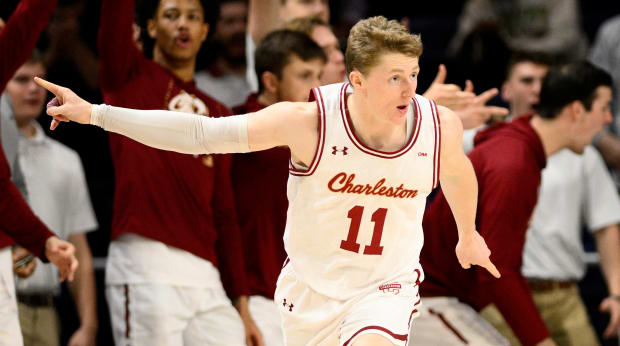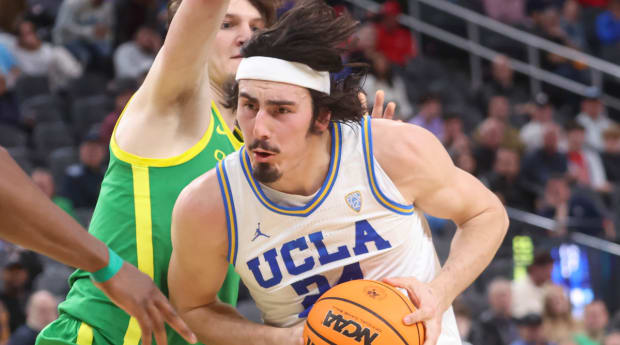Here are my 10 takeaways from the NCAA tournament men’s bracket reveal on Selection Sunday:
1. The potential for mayhem is real and spectacular.
As has been chronicled all season, the sport’s top tier is thin and fickle. No teams from Power 6 conferences have lost fewer than five games; the AP No. 1 ranking changed hands seven times and 14 different teams have been ranked in the top five; only three teams among the top 12 seeds won both their regular-season and postseason championships (Alabama, Purdue and Marquette). And there are some major injury and health concerns among the contenders (see below).
Meanwhile, the lower half of the bracket looks like one of the strongest in recent memory. There were relatively few upsets in the mid-major conference tournaments, which means most of the best teams from that strata advanced to this tourney. Fourteen teams from one-bid leagues have won at least 25 games, and three have won 30 or more. Three are led by coaches who have advanced to the Sweet Sixteen, at least (Iona’s Rick Pitino, Northern Kentucky’s Darrin Horn and Oral Roberts’s Paul Mills). There are several veteran mid-major teams who have been to the Big Dance before and gained valuable experience.
Among the most attractive double-digit seeds: all four No. 12s (Charleston, Drake, VCU and Oral Roberts); all four 13s (Furman, Kent State, Louisiana and Iona); No. 14 UC-Santa Barbara; No. 15 Colgate; No. 16 Northern Kentucky.
If ever we were set up for an attack of the mid-majors, this year would seem to be it.

Nick Wass/AP
2. Controversy be damned, Alabama is the clear overall No. 1 seed.
The tournament selection committee made a basketball decision, and a basketball decision only, in tabbing the Crimson Tide as the top overall seed. The residue from player Darius Miles being indicted on a capital murder charge, and the linking of star player Brandon Miller to the crime scene after delivering the alleged murder weapon in his car, has created a dark cloud over the program. But in pure on-court terms, nobody has had a better season than Alabama (29–5).
Alabama’s closest competition for the overall top seed prior to Sunday was Houston, which was No. 1 ahead of the Tide in the NCAA NET rankings and several other metrics-based ratings. But the Cougars lost head-to-head at home to Alabama in December, and the status of leading scorer Marcus Sasser is at least somewhat in doubt after he injured a groin Saturday in the American Athletic Conference tournament. Sasser did not play in the AAC title game Sunday against Memphis, where Houston was beaten handily by the Tigers.
For story line purposes, making a different team the top No. 1 seed would have slightly alleviated any NCAA discomfort that comes with the Tide. But there really was no viable alternative—and after watching Kansas cut down the nets last spring while under investigation for major rules violations, this is simply one more complicated chapter in college basketball.
3. The committee did some interesting geography gymnastics.
In granting Houston the second No. 1 seed over Kansas, the committee took the Jayhawks off a gilded backyard path to the Final Four. The Cougars, not the Jayhawks, are the Midwest No. 1 seed and—if they win two games—will play in Kansas City. That’s long been considered Lawrence East for Kansas, which now will be routed through Des Moines and then Las Vegas, if it advances.
However, Houston got some shabby treatment in the opening weekend. And so did No. 8 seed Iowa. Both of those teams were sent to Birmingham—along with No. 9 Auburn. The Tigers were given a cushy travel schedule and the chance for their home fans to gobble up tickets for games against higher-seeded teams.
4. Who is missing—at least tentatively—is almost as important as who is playing.
In addition to Sasser, the injury status of several other key players could play a huge part in how this tournament unfolds. UCLA, a No. 2 seed, lost defensive ace Jaylen Clark to what reportedly was an Achilles tendon injury that will end his season (the school has offered no confirmation or denial of that report), and the Bruins were without shot-blocking big man Adem Bona for the Pac-12 title game Saturday after injuring a shoulder. Texas, also a No. 2 seed, won the Big 12 tournament without forward Timmy Allen (10.5 points, a team-high 5.5 rebounds per game), who was listed as “day-to-day” after a lower leg injury. And Tennessee’s hopes for a long tourney run were dealt a major blow by the season-ending knee injury suffered by point guard Zakai Zeigler.
SWEENEY: Jaylen Clark’s Injury Is a Crushing Blow to UCLA’s Title Hopes
Looming just as large as those player issues is the health status of Kansas coach Bill Self, who had a heart issue before the Big 12 tournament. The man who has led the Jayhawks to two national championships did not coach after being hospitalized for a catheterization procedure and the insertion of two stents to alleviate blockage last week. Kansas assistant Norm Roberts, who filled in as the acting head coach, said Self will be back for the NCAA tourney. The question is whether he will be up to a full workload amid the stress and long hours of tournament competition.
Also: committee chair Chris Reynolds said an injury played a role in Rutgers not making the field. The Scarlet Knights were just 3–7 after forward Mawot Mag suffered a season-ending injury.
5. Hard to blame Oklahoma State for uncharitable thoughts toward various arms of the NCAA.
The Cowboys will miss their second straight NCAA tournament for two different reasons. This year, the Cowboys were the first team out of the field, edged out by Nevada for the 68th spot. Last year, the Cowboys were banned from postseason play by the NCAA Committee on Infractions for their implication in the federal probe of corruption in college basketball—making them the only program to date that was caught up in that scandal to have been hit with that penalty.
6. There is a throwback familiarity to this tournament.
With plenty of established players sticking around the college game—due in part to NIL opportunities and in part to their limited NBA upsides—we will see a lot of recognizable faces in starring roles.
Drew Timme is back for seemingly his 23rd NCAA run at Gonzaga. UCLA standouts Jaime Jaquez Jr. and Tyger Campbell have been in the starting lineup for four years, including the Bruins’ Final Four run of 2021. Purdue’s Zach Edey has been a towering post presence for three seasons. Oscar Tshiebwe at Kentucky, Trayce Jackson-Davis at Indiana, Jalen Wilson at Kansas, Jamal Shead at Houston, Jeremy Roach at Duke, Max Abmas at Oral Roberts—they’re all as familiar as the neighbors you see at the grocery store.
The North Carolina quartet of Armando Bacot, R.J. Davis, Leaky Black and Caleb Love could have added to that feel, but, well …
In a sport that had become quite transient, with players coming and going so quickly that it was difficult to latch on to them, this is a welcome change.

Chase Stevens/AP
7. Coach K is missing—but his proteges are not.
Mike Krzyzewski retired after last year’s Final Four run, but the winningest coach in Division I men’s basketball history still has his influence on the bracket. Replacement Jon Scheyer leads a red-hot Duke in the East Regional as a No. 5 seed; former assistant Chris Collins led Northwestern to its highest ever seeding (No. 7); former assistant Jeff Capel squeaked Pittsburgh into the field as a First Four entrant; and former Blue Devil player Kenny Blakeney has guided Howard into the tourney for the first time since 1992.
8. The power of a single play in the course of a long season.
Some of the impactful ones that helped shape the tournament:
Desmond Cambridge Jr.’s 55-foot prayer for Arizona State to beat Arizona in Tucson assuredly meant the different between NCAA and NIT for the No. 11 Sun Devils.
Back on Jan. 23, a controversial flagrant foul call against New Mexico big man Morris Udeze at Nevada allowed the Wolf Pack to tie the game and send it into overtime, whereupon Nevada won 97–94. Nevada was the last team in the tournament.
Two free throws by Jamarius Burton in the final seconds sent Pittsburgh past North Carolina on Feb. 1, which might have been the margin by which one team made the tourney and one did not. Also, Carolina’s four-overtime loss to Alabama on Nov. 27 in Portland now looms large.
9. There is a strong Texas flavor to the tourney.
The Final Four will be in Houston, and there are a lot of Lone Star teams that would love to get there. That starts with two from that very city—the No. 1 seeded Houston Cougars and No. 16 Texas Southern Tigers. (One of those two has a slightly better chance than the other.) There’s also No. 2 seed Texas, No. 7 seed Texas A&M, No. 3 seed Baylor, No. 6 seed TCU and No. 16 seed Texas A&M-Corpus Christi.
10. Coaching under pressure.
The only coach of a team among the top eight seeds who has won a national title is Self. Purdue’s Matt Painter is fighting a succession of disappointing early tournament exists. Marquette’s Shaka Smart has lost six straight NCAA tournament first-round games. Tennessee’s Rick Barnes has made just one Sweet Sixteen in the last 16 years. Iowa’s Fran McCaffrey has never made a Sweet Sixteen in more than 20 years as a college head coach.







